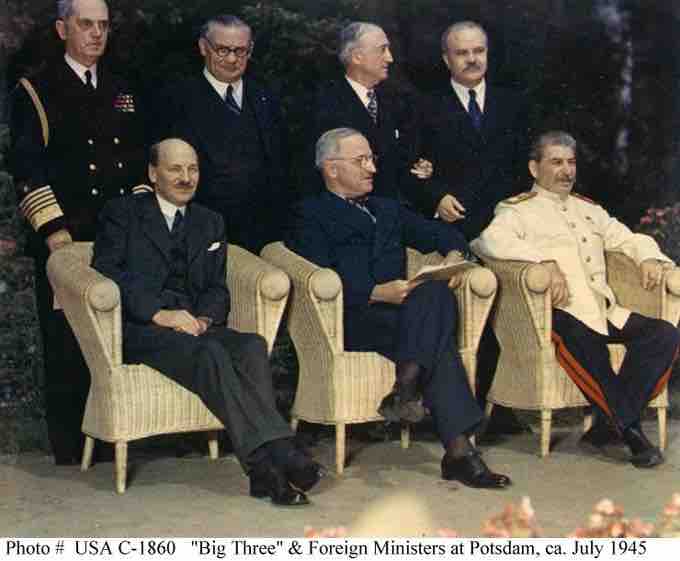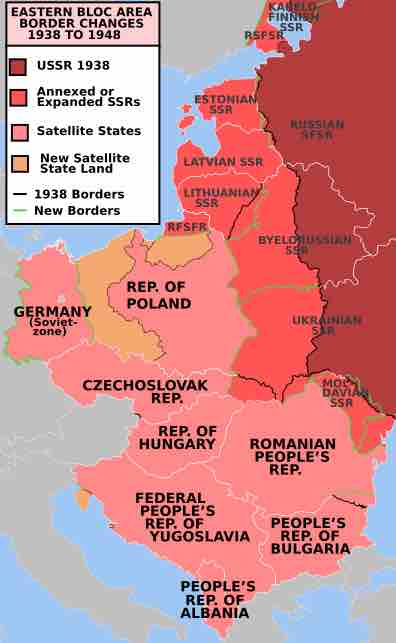Origins of the Cold War
The Origins of the Cold War are widely regarded to lie most directly in the relations between the Soviet Union and the allies (the United States, Great Britain and France) in the years 1945–1947. Those events led to the Cold War that endured for just under half a century.
Events preceding the Second World War, and even the Russian Revolution of 1917, underlay pre–World War II tensions between the Soviet Union, western European countries and the United States. A series of events during and after World War II exacerbated tensions, including the Soviet-German pact during the first two years of the war leading to subsequent invasions, the perceived delay of an amphibious invasion of German-occupied Europe, the western allies' support of the Atlantic Charter, disagreement in wartime conferences over the fate of Eastern Europe, the Soviets' creation of an Eastern Bloc of Soviet satellite states, western allies scrapping the Morgenthau Plan to support the rebuilding of German industry, and the Marshall Plan.
Pre-World War II Tensions
As a result of the 1917 Bolshevik Revolution in Russia, followed by its withdrawal from World War I, Soviet Russia found itself isolated in international diplomacy. Leader Vladimir Lenin stated that the Soviet Union was surrounded by a "hostile capitalist encirclement" and he viewed diplomacy as a weapon to keep Soviet enemies divided, beginning with the establishment of the Soviet Comintern, which called for revolutionary upheavals abroad.Tensions between Russia (including its allies) and the West turned intensely ideological.
After winning the civil war, the Bolsheviks proclaimed a worldwide challenge to capitalism. Subsequent Soviet leader Joseph Stalin, who viewed the Soviet Union as a "socialist island," stated that the Soviet Union must see that "the present capitalist encirclement is replaced by a socialist encirclement." As early as 1925, Stalin stated that he viewed international politics as a bipolar world in which the Soviet Union would attract countries gravitating to socialism and capitalist countries would attract states gravitating toward capitalism while the world was in a period of "temporary stabilization of capitalism" preceding its eventual collapse.
Differences in the political and economic systems of Western democracies and the Soviet Union—socialism versus capitalism, economic autarky versus free trade, state planning versus private enterprise—became simplified and refined in national ideologies to represent two ways of life. The atheistic nature of Soviet communism concerned many Americans. The American ideals of free determination and President Woodrow Wilson's Fourteen Points conflicted with many of the USSR's policies.
Conflicting Post-War Goals
Several postwar disagreements between western and Soviet leaders were related to their differing interpretations of wartime and immediate post-war conferences. At the February 1945 Yalta Conference, they could not reach firm agreements on crucial postwar questions like the occupation of Germany and postwar reparations from Germany. Given Russia's historical experience of frequent invasions and the immense death toll of the war (estimated at 27 million), the Soviet Union sought to increase security by dominating the internal affairs of countries that bordered it. Stalin was determined to use the Red Army to gain control of Poland, to dominate the Balkans and to destroy utterly Germany's capacity to engage in another war. On the other hand, the United States sought military victory, the achievement of global American economic supremacy, and the creation of an intergovernmental body to promote international cooperation. The key to the US vision of security was a post-war world shaped according to the principles laid out in the 1941 Atlantic Charter—in other words, a liberal international system based on free trade and open markets. This vision would require a rebuilt capitalist Europe, with a healthy Germany at its center, to serve once more as a hub in global affairs.
At the Potsdam Conference in July 1945, the Allies met to decide how to administer the defeated Nazi Germany. Serious differences emerged over the future development of Germany and Eastern Europe. At Potsdam, the U.S. was represented by President Harry S. Truman, who relied on a set of advisers who took a harder line toward Moscow than his predecessor Franklin Roosevelt. Under Truman's administration, officials favoring cooperation with the Soviet Union and the incorporation of socialist economies into a world trade system were marginalized. The atomic bombings of Hiroshima and Nagasaki were, in part, a calculated effort on the part of Truman toward intimidating the Soviet Union, limiting its influence in the post war Asia. Indeed, the bombings served to fuel Soviet distrust of the United States and are regarded by some historians not as only as the closing act of World War II, but as the opening salvo of the Cold War.

Potsdam Conference 1945
UK Prime Minister Clement Attlee, U.S. President Harry Truman and Soviet Premier Joseph Stalin at the Potsdam Conference, July 1945
US: Prosperity Based in Open Markets
US leaders hoped to shape the postwar world by opening up markets to international trade. The US, as the world's greatest industrial power and as one of the few countries physically unscathed by the war, stood to gain enormously from opening the entire world to unfettered trade. The US would have a global market for its exports, as well as unrestricted access to vital raw materials. Determined to avoid another economic catastrophe like that of the 1930s, US leaders saw the creation of the postwar order as a way to ensure continuing prosperity.
Such a Europe required a healthy Germany at its center. The postwar U.S. was an economic powerhouse that produced 50% of the world's industrial goods and an unrivaled military power with a monopoly of the new atom bomb. It also required new international agencies: the World Bank and International Monetary Fund, which were created to ensure an open, capitalist, international economy. The Soviet Union opted not to take part.
Soviets: Prosperity Based in Security
The American vision of the postwar world conflicted with the goals of Soviet leaders who were also motivated to shape postwar Europe. Since 1924, the Soviet Union had placed a high priority on its own security and internal development. After the war, Stalin sought to secure the Soviet Union's western border by installing communist-dominated regimes under Soviet influence in bordering countries, called the Eastern Bloc. During and immediately after the war, the Soviet Union annexed several Eastern European countries as satellite states, a move viewed as expansionist and aggressive by Western powers. Many of these were originally countries effectively ceded to it by Nazi Germany in the Molotov-Ribbentrop Pact, before Germany invaded the Soviet Union. These later annexed territories include Eastern Poland, Latvia, Estonia, Lithuania, part of eastern Finland and northern Romania.

Border Changes in Eastern Europe from 1938 - 1948
Expansion of the USSR during WWII. The borders of Eastern bloc's members other than the USSR, Poland and Yugoslavia are shown in their post-war status.
Tensions Grow
In February 1946, U.S. diplomat George F. Kennan delivered a memo from his post in Moscow which came to be known as the Long Telegram. The Long Telegram sought to explain recent Soviet behavior to Kennan's superiors in Washington, and further advised a hard line against the Soviets. It argued that the Soviet Union was motivated by both traditional Russian imperialism and by Marxist ideology, which advocated the expansion of socialism and the toppling of capitalist regimes. In Kennan's view, Soviet behavior was inherently expansionist and paranoid, posing a threat to the United States and its allies.
That September, the Soviets produced the Novikov Telegram. This telegram, sent by the Soviet ambassador to the US, portrayed the US as being in the grip of monopolistic capitalists bent on building up military capability "to prepare the conditions for winning world supremacy in a new war." These differing interpretations of international politics in the immediate postwar era set the stage for a succession of diplomatic, economic, and military confrontations between the two powers.
On March 5, 1946, Winston Churchill gave a speech declaring that an "iron curtain" had descended across Europe. This metaphorical curtain divided east from west, leaving those nations behind it "subject, in one form or another, not only to Soviet influence but to a very high and in some cases increasing measure of control from Moscow." To the Soviets, the speech seemed to intended to incite the West to war with the USSR, as it called for a broad western alliance against the Soviets.
In response to perceived western aggression, in September 1947, the Soviets created Cominform to enforce orthodoxy within the international communist movement and tighten political control over Soviet satellites through coordination of communist parties in the Eastern Bloc. The Cold War had begun.